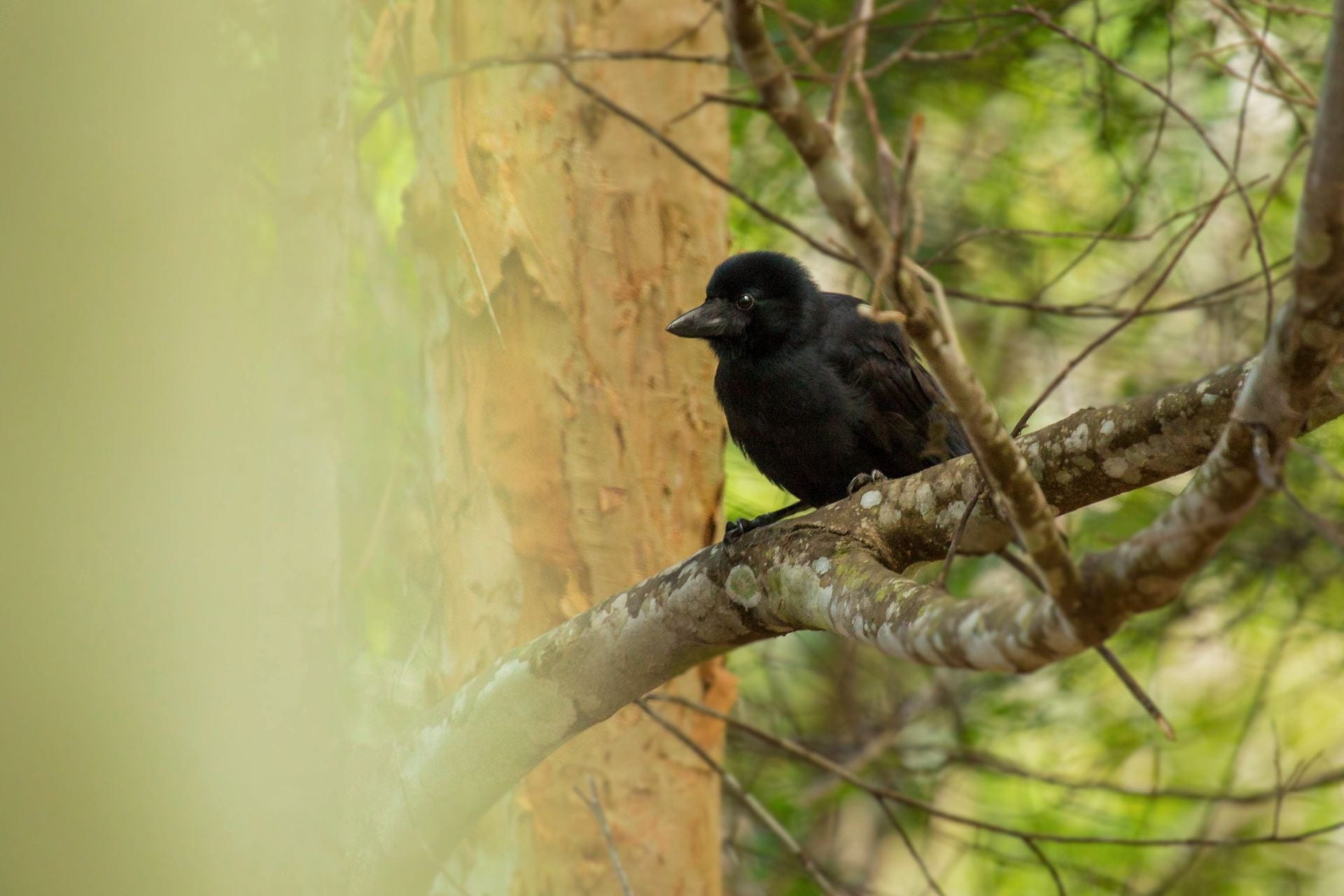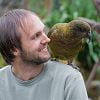About Us
Our work with New Caledonian crows (Corvus moneduloides) is based in a large outdoor aviary near La Foa, on the mainland (Grande Terre) of New Caledonia. Most of our research involves experiments with wild birds, using a catch-release programme. Birds are brought into the aviary for a few months each year and then released back into the wild.
New Caledonian crows are unique in that they are one of a few species that make and use tools for foraging in the wild. They are also the only species besides humans that produce hook tools. New Caledonian crows’ pandanus leaf tool designs vary across populations in different geographical areas. They are therefore an ideal model species for studying tool-related cognition and cumulative cultural evolution in non-humans.
Opportunities
The New Caledonian Crow Lab offers research opportunities from March to August each year, for students at PhD level and researchers from other institutions. If you are interested in working with us please contact Dr Alex Taylor.

Our Team
Media
Watch these videos to see New Caledonian crows in action:




Dr Alex Taylor
Director | Associate Professor
alexander.taylor@auckland.ac.nz
Dr Russell Gray
Co-director | Professor
rd.gray@auckland.ac.nz
Amalia Bastos
PhD Candidate
a.bastos@auckland.ac.nz
Patrick Wood
Field Site Technician
patrick.wood@auckland.ac.nz
Our work with New Caledonian crows has been featured widely in international media. Here are a few articles about our work:
- The Guardian, 29 June, 2018: Birdbrainy: New Caledonian crows make tools using mental images
- New York Times, 28 June, 2018: Can Crows Make Mental Pictures of Tools?
- Science, 17 September, 2012: Whodunnit? Crows ask that question, too
- The Guardian, 21 April 2010: In praise of… the New Caledonian crow
- The Telegraph, 17 September 2008: Crows may be smarter than apes
- BBC News, 16 August 2007: Cleverest crows opt for two tools
For media related enquiries, please contact Dr Alex Taylor.
Publications
Below is a list of our most recent publications:
Miller, R., Gruber, R., Frohnwieser, A., Schiestl, M., Jelbert, S. A., Gray, R. D., Boeckle, M., Taylor, A. H., Clayton, N. S. (2020) Decision-making flexibility in New Caledonian crows, young children and adult humans in a multi-dimensional tool-use task. PLoS One 15 (3). DOI: 10.1371/journal.pone.0219874
Miller, R., Frohnwieser, A., Schiestl, M., McCoy, D. E., Gray, R. D., Taylor, A. H., Clayton, N. S. (2019). Delayed gratification in New Caledonian crows and young children: influence of reward type and visibility. Animal Cognition 23 (6). DOI:10.1007/s10071-019-01317-7
McCoy, D. E., Schiestl, M., Neilands, P., Hassall, R., Gray, R. D., Taylor, A. H. (2019). New Caledonian Crows Behave Optimistically After Using Tools. Current Biology 29 (16), 2737-2742. e3.
Gruber, R., Schiestl, M., Boeckle, M., Frohnwieser, A., Miller, R., Gray, R. D., Clayton, N. S., Taylor, A. H. (2019). New Caledonian Crows use mental representations to solve metatool problems. Current Biology 29 (4), pp. 686 – 692.
Jelbert, S. A., Miller, R., Schiestl, M., Boeckle, M., Cheke, L. G., Gray, R. D., Taylor, A. H., Clayton, N. S. (2019). New Caledonian crows infer the weight of objects from observing their movements in a breeze. Proceedings of the Royal Society B: Biological Sciences, 286(1894): 20182332. doi:10.1098/rspb.2018.2332.
Jelbert, S. A., Hosking, R. J., Taylor, A. H., Gray, R. D. (2018). Mental template matching is a potential cultural transmission mechanism for New Caledonian crow tool manufacturing traditions. Scientific Reports, volume 8: 8956. DOI: https://doi.org/10.1038/s41598-018-27405-1
Knaebe, B., Taylor, A. H., Elliffe, D.H., & Gray, R. D. (2017). New Caledonian crows show behavioural flexibility when manufacturing their tools. Behaviour, 154 (1): 65-91. DOI: 10.1163/1568539X-00003411
Visalberghi, E., Sabbatini, G., Taylor, A. H., & Hunt, G. R. (2017). Cognitive insights from tool use in nonhuman animals. APA handbook of comparative psychology: Perception, learning, and cognition, Vol. 2, (pp. 673-701).
Neilands, P. D., Jelbert, S. A., Breen, A. J., Schiestl, M., & Taylor, A. H. (2016). How insightful is ‘insight’? New Caledonian crows do not attend to object weight during spontaneous stone dropping. PLOS ONE, 11(12): e0167419. DOI: 10.1371/journal.pone.0167419.
Miller, R., Jelbert, S. A., Taylor, A. H., Cheke, L. G., Gray, R. D., Loissel, E., & Clayton, N. S. (2016). Performance in object-choice Aesop’s Fable Tasks are influenced by object biases in New Caledonian crows but not in human children. PLOS ONE, 11(12): e0168056. DOI: 10.1371/journal.pone.0168056.
Taylor, A. H. (2016). Brainy birds. Current Biology, 26, R1-R3, July 25.
Jelbert, S. A., Taylor, A. H., & Gray, R. D. (2016). Does absolute brain size really predict self-control? Hand-tracking training improves performance on the A-not-B task. Biology Letters, 12: 20150871. DOI: 10.1098/rsbl.2015.0871.